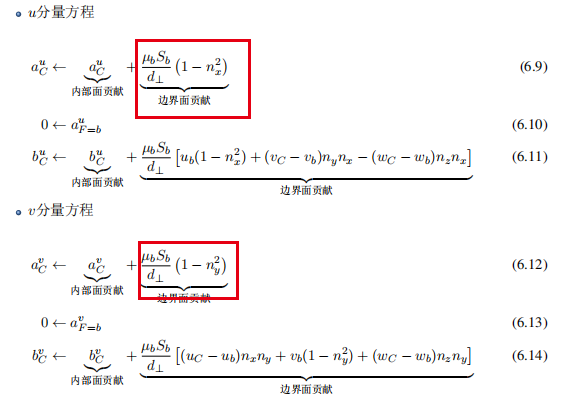重新看icoFoam
-
今天重新看OpenFOAM中的icoFoam求解器,有个疑问:在压力修正过程中,感觉每次求解的压力方程中的系数都没有变化。压力修正过程代码如下,压力方程中的rAU和HbyA都是从动量预测方程(UEqn)求出的,UEqn并没有随着U变化而变化,所以压力方程按理并没有发生变化,但是PISO算法中,压力方程中的系数是要随着速度的更新而更新的。那修改压力方程中系数的部分在什么地方?
while (piso.correct()) { volScalarField rAU(1.0/UEqn.A()); volVectorField HbyA(constrainHbyA(rAU*UEqn.H(), U, p)); surfaceScalarField phiHbyA ( "phiHbyA", fvc::flux(HbyA) + fvc::interpolate(rAU)*fvc::ddtCorr(U, phi) ); adjustPhi(phiHbyA, U, p); // Update the pressure BCs to ensure flux consistency constrainPressure(p, U, phiHbyA, rAU); // Non-orthogonal pressure corrector loop while (piso.correctNonOrthogonal()) { // Pressure corrector fvScalarMatrix pEqn ( fvm::laplacian(rAU, p) == fvc::div(phiHbyA) ); pEqn.setReference(pRefCell, pRefValue); pEqn.solve(mesh.solver(p.select(piso.finalInnerIter()))); if (piso.finalNonOrthogonalIter()) { phi = phiHbyA - pEqn.flux(); } } #include "continuityErrs.H" U = HbyA - rAU*fvc::grad(p); U.correctBoundaryConditions(); } -
volScalarField rAU(1.0/UEqn.A());按照道理说这个应该是矢量场才对,因为三个方向
volVectorField。 -
@winsway_zero 是三个方向,但是他们的对角线元素是一样的,
-
@李东岳 我下面仔细推导了一下:
首先rAU(1.0/UEqn.A());,这个公式的计算得到的结果是:对角系数
这是
A()函数:template<class Type> Foam::tmp<Foam::volScalarField> Foam::fvMatrix<Type>::A() const { tmp<volScalarField> tAphi ( volScalarField::New ( "A("+psi_.name()+')', psi_.mesh(), dimensions_/psi_.dimensions()/dimVol, extrapolatedCalculatedFvPatchScalarField::typeName ) ); tAphi.ref().primitiveFieldRef() = D()/psi_.mesh().V(); tAphi.ref().correctBoundaryConditions(); return tAphi; }这是D()对角系数的平均化处理
template<class Type> Foam::tmp<Foam::scalarField> Foam::fvMatrix<Type>::D() const { tmp<scalarField> tdiag(new scalarField(diag())); addCmptAvBoundaryDiag(tdiag.ref()); return tdiag; }边界对对角系数的影响:
template<class Type> void Foam::fvMatrix<Type>::addCmptAvBoundaryDiag(scalarField& diag) const { forAll(internalCoeffs_, patchi) { addToInternalField ( lduAddr().patchAddr(patchi), cmptAv(internalCoeffs_[patchi]), diag ); } }从上面的代码可以得到:
$$
A_p=\frac{\bar{D}}{\Delta V}
$$
其中:
$$
\bar{D}=average(a_p')+diag
$$
式子中average(Ap')表示的是边界对主对角线系数的影响的平均;diag表示的是内部面离散的主对角线系数。周围系数作为源项:
H()
template<class Type> Foam::tmp<Foam::GeometricField<Type, Foam::fvPatchField, Foam::volMesh>> Foam::fvMatrix<Type>::H() const { tmp<GeometricField<Type, fvPatchField, volMesh>> tHphi ( GeometricField<Type, fvPatchField, volMesh>::New ( "H("+psi_.name()+')', psi_.mesh(), dimensions_/dimVol, extrapolatedCalculatedFvPatchScalarField::typeName ) ); GeometricField<Type, fvPatchField, volMesh>& Hphi = tHphi.ref(); // Loop over field components for (direction cmpt=0; cmpt<Type::nComponents; cmpt++) { scalarField psiCmpt(psi_.primitiveField().component(cmpt)); scalarField boundaryDiagCmpt(psi_.size(), 0.0); addBoundaryDiag(boundaryDiagCmpt, cmpt); boundaryDiagCmpt.negate(); addCmptAvBoundaryDiag(boundaryDiagCmpt); Hphi.primitiveFieldRef().replace(cmpt, boundaryDiagCmpt*psiCmpt); } Hphi.primitiveFieldRef() += lduMatrix::H(psi_.primitiveField()) + source_; addBoundarySource(Hphi.primitiveFieldRef()); Hphi.primitiveFieldRef() /= psi_.mesh().V(); Hphi.correctBoundaryConditions(); typename Type::labelType validComponents ( psi_.mesh().template validComponents<Type>() ); for (direction cmpt=0; cmpt<Type::nComponents; cmpt++) { if (validComponents[cmpt] == -1) { Hphi.replace ( cmpt, dimensionedScalar(Hphi.dimensions(), 0) ); } } return tHphi; }template<class Type> void Foam::fvMatrix<Type>::addBoundaryDiag ( scalarField& diag, const direction solveCmpt ) const { forAll(internalCoeffs_, patchi) { addToInternalField ( lduAddr().patchAddr(patchi), internalCoeffs_[patchi].component(solveCmpt), diag ); } }这里面的求解过程包含了:
$$
H=\frac{\left [-\sum a_{\mathbf{N}}\mathbf{U_N} + (\mathbf{b}+\mathbf{b'})+(average(a_p')-a_p')\mathbf{U_C}\right]}{\Delta V}
$$最后:
$$
HbyA= \frac{H}{A}=\frac{\Delta V}{average(a_p')+diag}\frac{\left [-\sum a_{\mathbf{N}}\mathbf{U_N} + (\mathbf{b}+\mathbf{b'})+(average(a_p')-a_p')\mathbf{U_C}\right]}{\Delta V}
$$
$$
HbyA= \frac{H}{A}=\frac{\left [-\sum a_{\mathbf{N}}\mathbf{U_N} + (\mathbf{b}+\mathbf{b'})+(average(a_p')-a_p')\mathbf{U_C}\right]}{average(a_p')+diag}
$$

